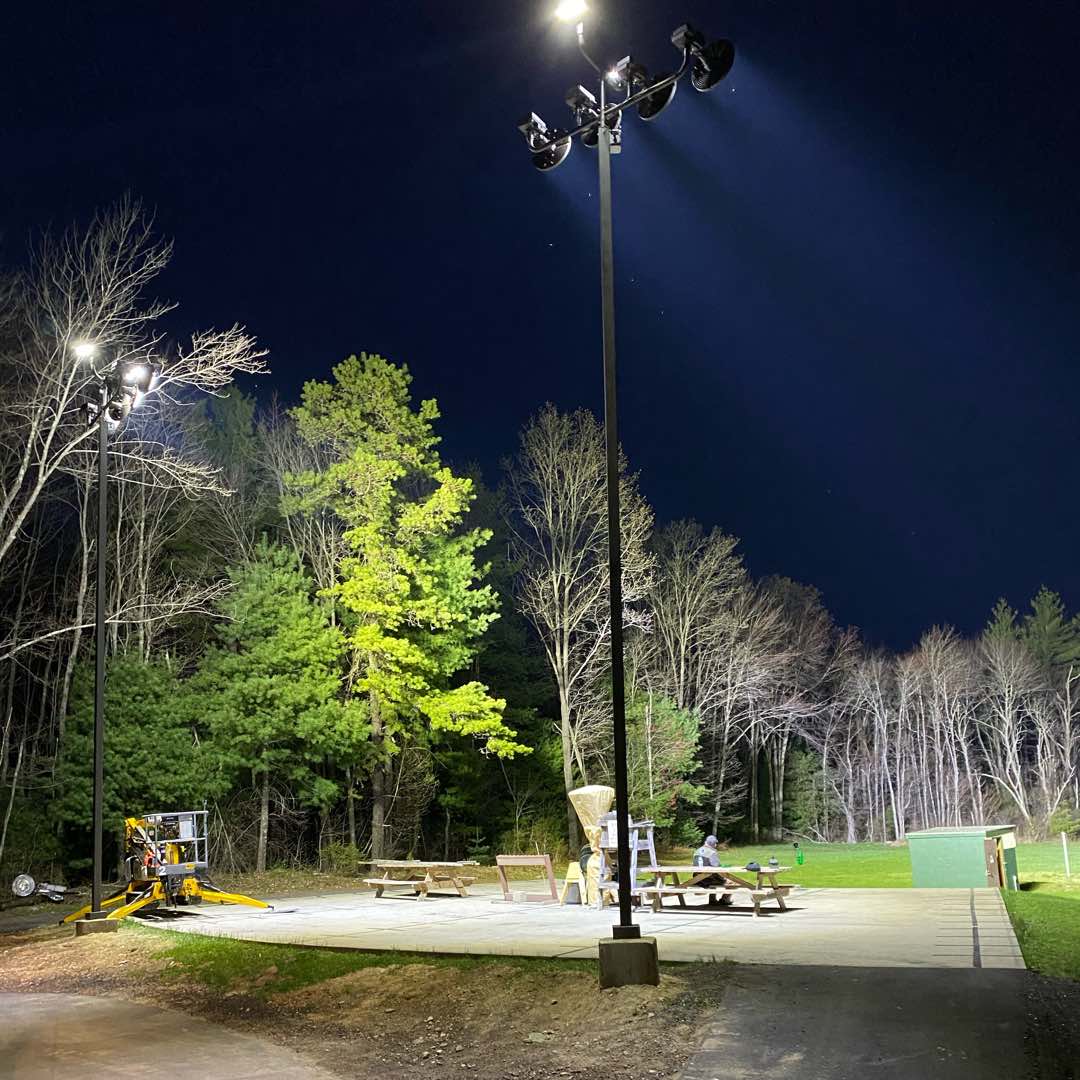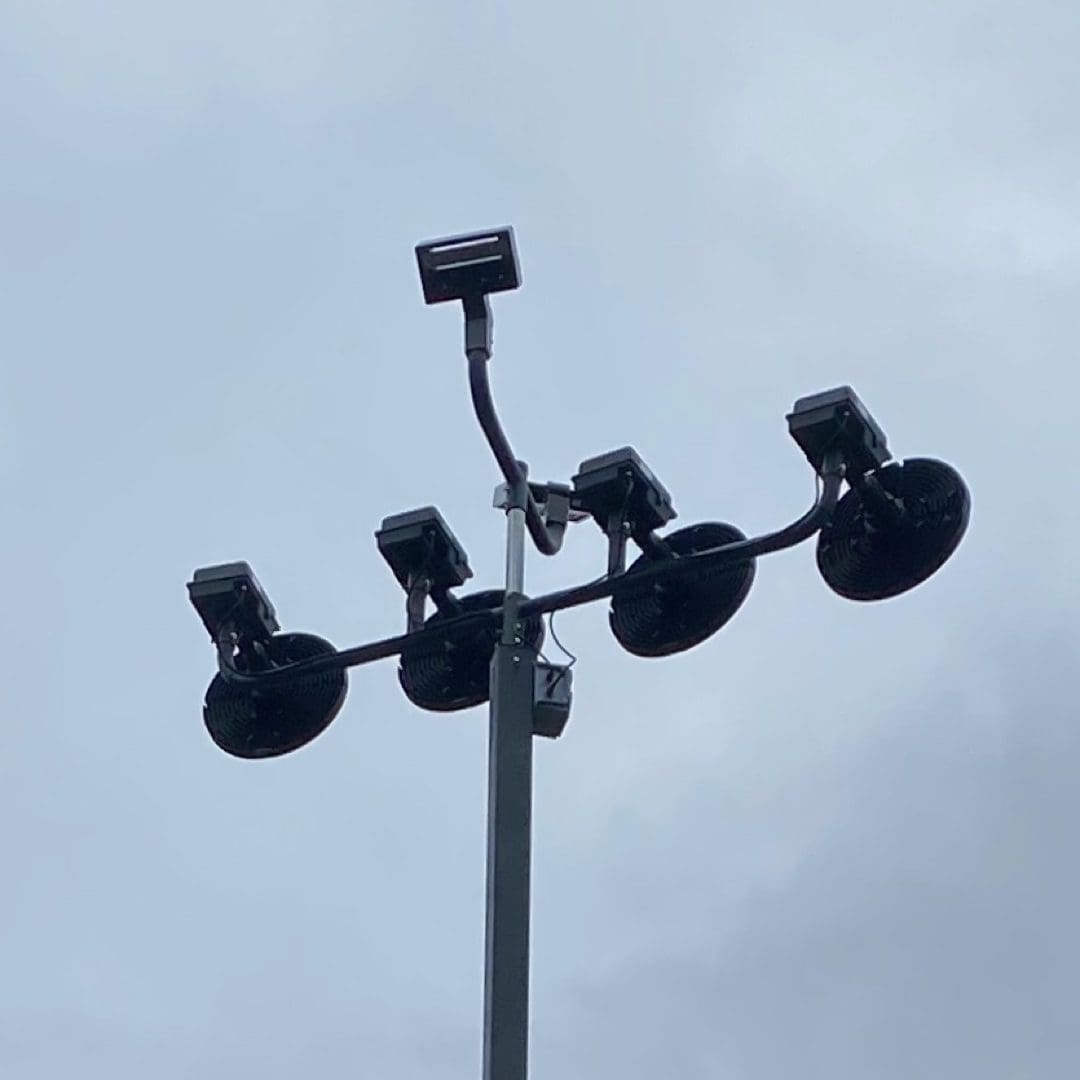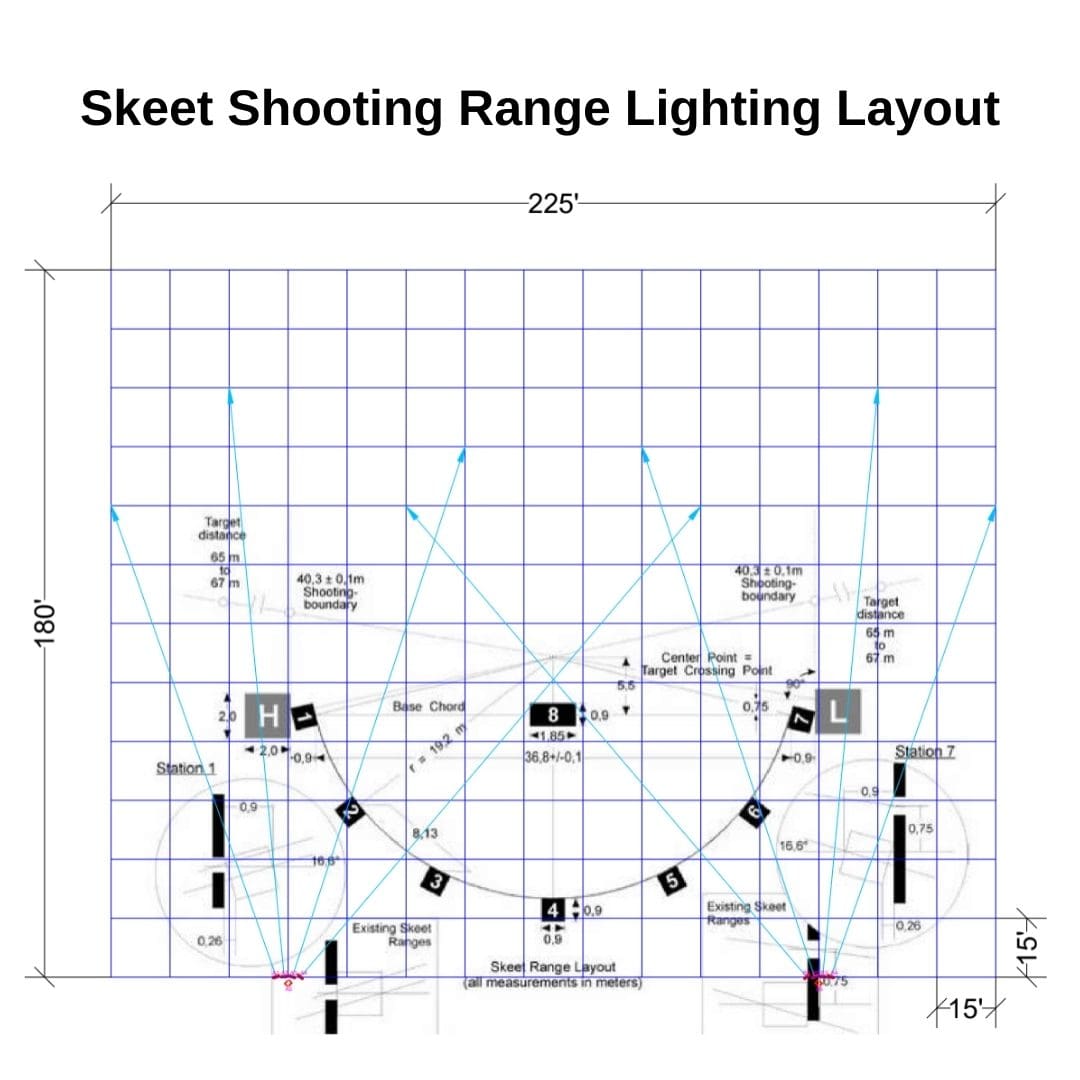Access Fixtures is no stranger to lighting unusual projects. High-performance lighting solutions is what we do, after all. When a sportsman’s club contacted us about lighting a trap and skeet range, we jumped in to help. Using our extensive knowledge of lighting and our experiences lighting similar locations including firing ranges, we were able to provide lighting solutions for this project that exceeded expectations.
Key Takeaways
-
-
Customized Lighting Enhances Safety and Performance: Proper lighting is essential in trap and skeet ranges for visibility, accuracy, and safety. Customized lighting layouts—factoring in vertical and horizontal illuminance, glare reduction, and appropriate brightness—significantly improve the shooting experience.
-
Photometric Analyses Are Critical for Success: Conducting a photometric analysis allows lighting professionals to tailor solutions based on range layout, target flight paths, fixture placement, and compliance with local regulations. This ensures even light distribution and optimal visibility across the range.
-
LED Fixtures Offer Efficiency and Longevity: LED lighting is the preferred solution for both trap and skeet ranges due to its energy efficiency, durability, reduced maintenance needs, and high-quality illumination. Products like STAD and APTA fixtures deliver performance tailored to outdoor range environments.
-
Understanding Range Lighting
Range lighting is a critical aspect of any shooting range, significantly impacting the mood and comfort of its users. Proper lighting is essential not only for visibility but also for creating an optimal shooting environment. Lighting experts collaborate with range designers and engineers to develop customized lighting layouts that cater to the specific needs of each range. The ideal lighting setup involves the right brightness, color temperature, and strategic positioning to ensure a comfortable and effective shooting experience. By working closely with professionals, range owners can create a well-lit environment that enhances both safety and performance.
Key Considerations for Shooting Ranges
Designing a shooting range involves several key considerations to ensure optimal functionality and safety. One of the primary concerns is reducing glare and reflections, which can distract shooters and impair their accuracy. Providing even illumination across the entire range is crucial for maintaining consistent visibility. Additionally, the type of shooting activity, the size and layout of the range, and local regulations must be taken into account. A professional lighting designer can help create a customized lighting plan that addresses these factors, ensuring that the range meets the specific needs of its users. By focusing on these important aspects, range owners can create a safe and effective shooting environment.
What is Trap Shooting?
Trap shooting is both a sport and a pastime that involves shooting clay pigeons, which are small discs made of clay. In trap shooting, clay pigeons are launched out of a machine called a house downrange from the shooter. The goal of trap shooting is to shoot as many clay pigeons as possible within an allotted time. Shotguns with lead shot ammunition are used and the size of the Trap shooting has become more popular in recent years and has been an Olympic sporting event since the early 1900s.
Lighting for a Trap Range
One of the obvious difficulties of lighting a trap range is making sure clear visibility is high in all areas of the range. This is both a safety issue and a performance issue. Both horizontal and vertical illuminance matters. The area where the shooters are located needs to be lit so that they can see their equipment clearly as well as see each other, and downrange needs to be lit so that the shooters can see the clay pigeons as they are launched. Additionally, bright lighting is essential to ensure clear visibility of firearms and equipment, enhancing safety for both range officers and shooters. Lighting solutions can be tailored to different budget constraints, ensuring that all financial considerations are met. Choosing the right bulbs, such as LED bulbs, is crucial for optimal lighting due to their brightness, energy efficiency, and longevity. Proper lighting placement is also important to minimize shadows and ensure continuous illumination throughout the range.
Here are some actual questions one of our lighting specialists asked a customer interested in lighting his trap range:
What is the height of the clay pigeons when you fire at them?
What is the approximate speed of a clay pigeon?
Are there any neighbors that would be aggravated by the lighting?
Are there any local regulations that we need to be aware of?
Can you locally source wood poles or will you want to go with steel poles?
Lighting experts can help in selecting the right fixtures and bulbs to ensure the best possible lighting setup. All of these questions are important when lighting a trap range because they deal with issues like pole height, light trespass, fixture wattage, and optics. Based on the answers to these questions, a photometric analysis can be generated.
For this particular project, we ended up combining STAD fixtures with APTA fixtures on 30′ poles. The STAD sports light was able to illuminate the shooting area and the APTA fixtures featured T5W optics that projected light far out downrange. The result was a perfect solution that allowed members of the sportsman’s club to shoot trap safely at night. Modern lighting solutions were used to enhance the range’s visibility. Stall lighting is also beneficial as it provides glare-free and strain-free illumination, enhancing visibility at the table and minimizing shadows.
Ceiling lighting is also important in indoor shooting ranges to ensure comprehensive visibility and safety.
What is Skeet Shooting?
Skeet shooting is a close relative of trap shooting in that it’s also a shooting sport that involves a shotgun and clay pigeons. The main difference between these two sports is that in trap shooting, there is one machine that launches clay pigeons downrange from the shooter, and in skeet shooting, there are typically two machines that launch clay pigeons across the shooter’s range of view simultaneously. Skeet shooting is also newer in that it was first created in 1920 in Andover, Massachusetts. Skeet is also an Olympic sport and there is quite a bit of overlap in fans of trap shooting and fans of skeet shooting.
Skeet Range Lighting
A customer contacted us recently looking for lighting for a skeet range at a sportsman’s club. Proper lighting enhances the experience on a skeet shooting course. Adapting to changes in lighting conditions is crucial for optimal performance. The range was currently utilizing old metal halide lighting that no longer worked or reached the target, and they were mounted on 20′ poles which didn’t distribute the light correctly. Certain types of lighting can fill the space effectively. The customer was looking for a solution that would create even lighting across the entire visual area of the range.
Like the trap lighting project, we ran a photometric analysis which took into consideration the concerns of the sporting club. In this photometric, we utilized eight STAD 500s with NEMA 3 optics mounted four apiece on two 30′ poles. The diagram to the right shows the location of the fixtures and the way the beam angles distribute light evenly across the shooting range. It is important to light the entire range for optimal visibility, especially the target area, to ensure even illumination and minimize shadows. We also highlighted the benefits of using LEDs for energy efficiency and brightness. This provided a much more efficient and effective solution for lighting a skeet range. The types of LED lights used for the skeet range were specifically chosen for their durability and brightness.
Different lighting styles can enhance the ambiance of the shooting range. Additionally, selecting the right lighting for different rooms or areas within the shooting range is crucial for both functionality and atmosphere.
Speak to an Access Fixtures Lighting Specialist to discuss your Range Lighting Project: Call 800-468-9925
LED Lighting Options
LED lighting options offer numerous benefits for shooting ranges, making them an excellent choice for both indoor and outdoor facilities. LED lights are known for their superior energy efficiency, consuming significantly less power compared to traditional lighting options like metal halide lights. They also have a much longer lifespan, which reduces the frequency and cost of replacements and maintenance. Additionally, LED lights provide high-quality illumination with customizable color temperatures and brightness levels, ensuring optimal visibility for shooters. By choosing LED lights, range owners can enjoy long-term cost savings and enhanced lighting performance.
Safety Considerations
Safety is a top priority in any shooting range, and proper lighting plays a crucial role in maintaining a safe environment. Adequate lighting helps reduce eye strain and improves visibility, allowing shooters to focus more effectively on their targets. Minimizing glare and reflections is essential, as these can impair a shooter’s vision and increase the risk of accidents. A well-designed lighting system ensures that all areas of the range are well-lit, preventing shadows and dark spots that could pose safety hazards. By prioritizing safety in their lighting design, range owners can create a secure and enjoyable shooting experience for all users.
Maintenance and Upkeep
Regular maintenance is essential to ensure the optimal performance and longevity of shooting range lighting. This includes routine tasks such as cleaning fixtures, inspecting electrical connections, and replacing lamps as needed. Conducting a photometric analysis can also be beneficial, as it simulates the lighting setup and provides detailed information on light levels, uniformity, and potential light trespass. By adhering to these maintenance practices, range owners can ensure that their lighting system continues to provide excellent visibility and safety for shooters. Consistent upkeep not only enhances the shooting experience but also extends the lifespan of the lighting equipment, offering long-term benefits.
Conclusion
In conclusion, there are many different ways to light a trap or skeet range. Sportsman’s clubs and other similar venues have plenty of options when it comes to safe and attractive lighting for their facilities. Do you have a sportsman’s club, trap range, or skeet range that you need to illuminate? Contact an Access Fixtures lighting specialist or request a photometric analysis. There is no sportsman’s club lighting project too big or too small for Access Fixtures.
Range Lighting Frequently Asked Questions (FAQs)
You have questions on high-performance LED trap and skeet range lighting. We have answers. If you have a question that isn’t answered below, contact an Access Fixtures lighting specialist at (800) 468-9925 or click here.
What type of lighting is best for a trap or skeet shooting range?
LED lighting is best due to its brightness, energy efficiency, long life, and ability to reduce glare and shadows.
What are the lighting challenges in trap and skeet ranges?
Lighting challenges include ensuring even illumination, minimizing glare and reflections, and maintaining visibility of fast-moving clay targets.
What is a photometric analysis, and why is it important?
A photometric analysis simulates lighting performance on a digital model of the range to determine optimal fixture types, placements, and light levels.
How high should the poles be for range lighting?
Pole height depends on the layout, but many ranges use 30′ poles to provide wide light coverage without causing glare or light spill.
What are the benefits of LED lighting for shooting ranges?
LED lights offer long lifespan, reduced energy costs, minimal maintenance, customizable color temperatures, and superior illumination.
Can lighting affect the accuracy of shooters?
Yes. Poor lighting can cause eye strain, reduce target visibility, and create shadows or glare that distract or impair shooters’ focus.
What should be illuminated on a trap or skeet range?
Both shooter areas and downrange target zones should be well-lit. Stall lighting can also improve equipment visibility and reduce strain.
How do you reduce light spill or trespass on nearby properties?
By using precise optics, aiming fixtures correctly, and conducting a photometric analysis, you can minimize unwanted light beyond the range.
Are there specific regulations for range lighting?
Yes, local ordinances may regulate light levels, trespass, or wildlife impacts. Consulting with a lighting specialist ensures compliance.
What questions should I be prepared to answer when planning range lighting?
Expect questions about target speed and height, pole preferences, nearby neighbors, and existing infrastructure.
How often should range lighting be maintained?
Regular maintenance such as cleaning fixtures and inspecting connections helps preserve performance and safety. LEDs reduce the frequency of replacement.
What is the difference between trap and skeet lighting requirements?
Trap lighting must illuminate targets moving away from the shooter, while skeet lighting must evenly cover lateral and crossing flight paths from two machines.




